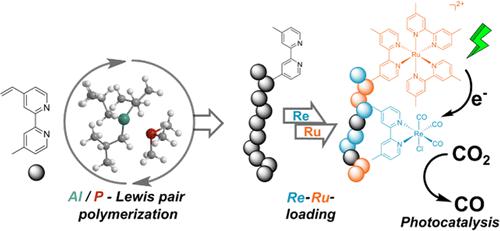当前位置:
X-MOL 学术
›
Macromolecules
›
论文详情
Our official English website, www.x-mol.net, welcomes your
feedback! (Note: you will need to create a separate account there.)
Macromolecular Rhenium–Ruthenium Complexes for Photocatalytic CO2 Conversion: From Catalytic Lewis Pair Polymerization to Well-Defined Poly(vinyl bipyridine)–Metal Complexes
Macromolecules ( IF 5.1 ) Pub Date : 2022-06-23 , DOI: 10.1021/acs.macromol.2c00440 Anton S. Maier 1 , Christopher Thomas 1 , Moritz Kränzlein 1 , Thomas M. Pehl 1 , Bernhard Rieger 1
Macromolecules ( IF 5.1 ) Pub Date : 2022-06-23 , DOI: 10.1021/acs.macromol.2c00440 Anton S. Maier 1 , Christopher Thomas 1 , Moritz Kränzlein 1 , Thomas M. Pehl 1 , Bernhard Rieger 1
Affiliation

|
Herein, the first catalytical polymerization of 4-vinyl-4′-methyl-2,2′-bipyridine (VBpy) via Lewis pair-mediated group-transfer polymerization using different combinations of Lewis acidic trialkyl aluminum compounds and Lewis basic phosphines is reported. In this context, a broad screening of different Lewis pairs is conducted, demonstrating the necessity of an adjustment of the steric and electronic properties of the Lewis pair to the demands of the monomer. Further, end-group analysis of short-chain oligomers via electrospray ionization mass spectrometry (ESI-MS) for the experimentally determined optimum combination Al(i-Bu)3/PMe3 (Đ = 1.31–1.36, I.E. = 45–51%) reveals the presence of two initiation pathways via conjugate addition and deprotonation. The well-defined polymers are subsequently loaded in a two-step synthesis protocol with different ratios of Re(CO)5Cl and Ru(dmb)2Cl2, forming a photocatalytically active rhenium–ruthenium polymer complex with poly(vinyl bipyridine) as the macroligand. Catalyst loadings are characterized thoroughly by means of Ultraviolet–visible (UV–vis), photoluminescence (PL), and IR spectroscopy as well as inductively coupled plasma (ICP)-MS. Finally, a comparison of the photocatalytic CO2 reduction performance of the polymeric catalysts in irradiation experiments is presented, revealing particularly high photostabilities and activities for PVBpy5/95 (TON = 5650, TOF = 66 h–1). This is due to an efficient electron transfer of the Ru(II)-one-electron-reduced species (OERS) to the rhenium centers facilitated by the spatial proximity of both metals attached to the macromolecular ligand PVBpy.
中文翻译:

用于光催化 CO2 转化的大分子铼-钌配合物:从催化路易斯对聚合到定义明确的聚(乙烯基联吡啶)-金属配合物
本文报道了使用路易斯酸性三烷基铝化合物和路易斯碱性膦的不同组合,通过路易斯对介导的基团转移聚合首次催化聚合 4-乙烯基-4'-甲基-2,2'-联吡啶 (VBpy)。在这种情况下,对不同的路易斯对进行了广泛的筛选,证明了调整路易斯对的空间和电子特性以满足单体需求的必要性。此外,通过电喷雾电离质谱 (ESI-MS) 对短链低聚物进行端基分析,得到实验确定的最佳组合 Al( i- Bu) 3 /PMe 3 ( Đ= 1.31–1.36,IE = 45–51%)揭示了通过共轭添加和去质子化存在两种起始途径。随后将定义明确的聚合物加载到具有不同比例的 Re(CO) 5 Cl 和 Ru(dmb) 2 Cl 2的两步合成方案中,形成具有光催化活性的铼-钌聚合物络合物与聚(乙烯基联吡啶)作为大配体。通过紫外-可见 (UV-vis)、光致发光 (PL) 和 IR 光谱以及电感耦合等离子体 (ICP)-MS 彻底表征催化剂负载量。最后,光催化CO 2的比较展示了聚合物催化剂在辐照实验中的还原性能,揭示了PVBpy 5/95 (TON = 5650, TOF = 66 h –1 ) 的特别高的光稳定性和活性。这是由于连接到大分子配体 PVBpy 的两种金属的空间接近性促进了 Ru(II)-单电子还原物质 (OERS) 到铼中心的有效电子转移。
更新日期:2022-06-23
中文翻译:

用于光催化 CO2 转化的大分子铼-钌配合物:从催化路易斯对聚合到定义明确的聚(乙烯基联吡啶)-金属配合物
本文报道了使用路易斯酸性三烷基铝化合物和路易斯碱性膦的不同组合,通过路易斯对介导的基团转移聚合首次催化聚合 4-乙烯基-4'-甲基-2,2'-联吡啶 (VBpy)。在这种情况下,对不同的路易斯对进行了广泛的筛选,证明了调整路易斯对的空间和电子特性以满足单体需求的必要性。此外,通过电喷雾电离质谱 (ESI-MS) 对短链低聚物进行端基分析,得到实验确定的最佳组合 Al( i- Bu) 3 /PMe 3 ( Đ= 1.31–1.36,IE = 45–51%)揭示了通过共轭添加和去质子化存在两种起始途径。随后将定义明确的聚合物加载到具有不同比例的 Re(CO) 5 Cl 和 Ru(dmb) 2 Cl 2的两步合成方案中,形成具有光催化活性的铼-钌聚合物络合物与聚(乙烯基联吡啶)作为大配体。通过紫外-可见 (UV-vis)、光致发光 (PL) 和 IR 光谱以及电感耦合等离子体 (ICP)-MS 彻底表征催化剂负载量。最后,光催化CO 2的比较展示了聚合物催化剂在辐照实验中的还原性能,揭示了PVBpy 5/95 (TON = 5650, TOF = 66 h –1 ) 的特别高的光稳定性和活性。这是由于连接到大分子配体 PVBpy 的两种金属的空间接近性促进了 Ru(II)-单电子还原物质 (OERS) 到铼中心的有效电子转移。











































 京公网安备 11010802027423号
京公网安备 11010802027423号